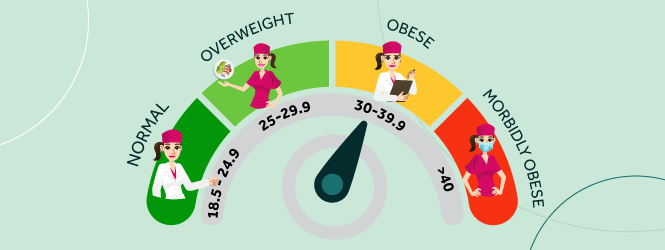
Obesity and morbid obesity are complex diseases that are not caused by one single issue. Many things factor into the equation that leads an individual to gain weight to the point of threatening their health, such as the environment they grew up in, underlying medical conditions that prevent them from maintaining a healthy weight, or sedentary lifestyles. Whichever the reason may be, obesity has become a global problem that affects millions of people of varying ages.
Obesity affects everyone around the world with data suggesting that “the number of obese people in the world has tripled since 1975 to roughly 30% of the total population”[1], and this number continues to rise.
Just as there are many causes for obesity, there are also many consequences that may arise if a person is battling with extra weight. This disorder is one of the leading causes of death because it dramatically decreases a person’s life expectancy. Obesity puts people at higher risk for several diseases or illnesses, such as: diabetes, heart disease, osteoarthritis, sleep apnea, strokes, and high blood pressure.
Many patients here at LIMARP® ask us: “What is Morbid Obesity?” This condition occurs in patients with a body mass index or BMI of over 40, up to 16 points above the expected range. While a healthy range for BMI depends on the individual, a BMI of over 40 often puts you at risk for many health conditions, including type 2 diabetes, heart disease, back pain, sleep apnea and high blood lipids.
For many patients affected by obesity, losing weight is much more difficult at a higher BMI. In these situations, bariatric surgery is often a reliable option for losing weight quickly and managing health problems. This article will focus on morbid obesity and how to treat and alleviate the symptoms that may present themselves.
Patients from all different backgrounds arrive at LIMARP® because they’re looking to improve their quality of life and embark on a healthier path. Our multidisciplinary team, led by Dr. Liza María Pompa González, offers different health services to help you reach your weight goals and beat obesity: from diet and exercise plans, to psychological guidance and surgical intervention.
Morbid obesity impacts everyone in a different way and the comorbidities that come along with it can vary from person to person, but we still recommend that you talk with your doctor if you start developing any symptoms that are affecting your overall health.
Dr. Liza María Pompa González and her team have performed thousands of bariatric surgery procedures for patients with morbid obesity at our Tijuana clinic to dramatically increase their quality of life and improve their overall health.
What makes obesity different from morbid obesity?
Obesity is an abnormal or excessive accumulation of fat that can cause illness and significant risks for your health. Obesity can be calculated by a variety of tests, including simple ones like measuring your body mass index (BMI). Patients with a BMI over 25 are considered overweight and patients with a BMI over 30 are considered obese, a trained physician can help you determine if your weight is at an unhealthy level.
The harsh reality is that obesity is a public health issue that is on the rise worldwide, affecting an increasing number of adults and children every year. Obesity is the result of excess fat stores within the body that cause systemic inflammation, it generally occurs when you consume more calories than you burn through daily physical activity or exercise. Many patients who are overweight or obese also have a genetic predisposition for the disease. A person is more likely to be obese if one of their parents is obese, or if their family has a similar, unhealthy lifestyle.
Morbid obesity is a condition that occurs in patients with a body mass index or BMI of over 40, up to 16 points above the expected range. An individual may also be considered morbidly obese if they are 100 pounds overweight or if they have a BMI above 35 accompanied by unfavorable obesity-related health conditions, such as high blood pressure or diabetes.
The consequences for these types of obesity are basically the same, but they can worsen if the patient has developed morbid obesity.
Some of these consequences or complications include: Type 2 diabetes, sleep apnea, heart disease, stroke, cerebral hemorrhage, gallstones, osteoarthritis, rheumatoid arthritis, infertility, obesity hypoventilation syndrome, and certain cancers.
How to Identify Morbid Obesity
BMI is a screening tool so it does not diagnose a person’s overall health. A trained health care provider or doctor should perform appropriate tests to evaluate an individual’s health status and risks. However, it is used to determine if a person is under or overweight according to their height. The CDC[2] uses the following parameters to determine the category a person falls into according to their weight:
- If your BMI is less than 18.5, it falls within the underweight range.
- If your BMI is 18.5 to <25, it falls within the healthy weight range.
- If your BMI is 25.0 to <30, it falls within the overweight range.
- If your BMI is 30.0 or higher, it falls within the obesity range.
Obesity is subdivided into categories or classes:
- Class 1: BMI of 30 to < 35
- Class 2: BMI of 35 to < 40
- Class 3: BMI of 40 or higher. Class 3 obesity is sometimes categorized as “severe” obesity or morbid obesity.
We have been using the term “morbid obesity” and continue to do so for the remainder of the article, but it’s important to point out that doctors have been recently adopting the term “class 3 obesity” in order to avoid the connotations that come with the word “morbid”. In a medical setting, “morbidity” means illness or disease, while “comorbidity,” which means that an individual has more than one illness or disease occurring at the same time.
The medical meaning of “morbid” is appropriate in describing this type of obesity since class III obesity is considered a disease and is often associated with other chronic health conditions[3].
Who is More Affected by Morbid Obesity?
Obesity, in all its classes, affects both children and adults, but there are statistics that display that morbid obesity can be different according to sex, age, and race. There are also several factors aside from diet and lack of physical activity that can contribute to a person developing morbid obesity. One of them is genetics, as it has been observed that obesity can run in the family.
Hormone imbalances can also worsen a person’s obesity because they affect how your body signals that you need food and how your body uses energy. An imbalance in cortisol affects a person’s appetite, especially if they experience chronic stress; this can lead them to crave food that’s not healthy for them and to eat it in excessive amounts. Another hormone imbalance can be seen in hypothyroidism where a person’s metabolism is deeply affected; having low thyroid hormone levels can lead a person to gain weight, as well as having trouble losing it.
There are also external factors, such as environmental and socioeconomic, that can heavily influence a person’s food choices and general lifestyle. This can be seen in the access there is to healthy meals and how it’s more likely that high-processed foods are more affordable and easier to make. A person’s social networks can also come into play.
Habits can influence your health and they can spread through social networks in much the same way that germs spread through communities, researchers from Harvard Medical school suspect that “a social network influences what its members perceive as normal and acceptable. If people see their friends becoming heavier and heavier over time, they may accept weight gain as natural, even inevitable. Instead of exercising more or eating less when their weight begins to creep up, they may simply go with the flow and join the crowd”. [4]
How to Diagnose Morbid Obesity
As we’ve stated before, BMI is not the sole indicator that a person has morbid obesity and there are plenty of tests a person has to undergo to determine if they do, in fact, have class 3 obesity. Some of these tests may include:
- Complete blood count
- Basic metabolic panel
- Kidney (renal) function tests
- Liver function tests
- Lipid panel
- Hemoglobin A1C (HbA1C)
- Thyroid-stimulating hormone (TSH) test
- Vitamin D levels test
- Urinalysis
- C-reactive protein (CRP) test
How to Treat Morbid Obesity
If a patient is dealing with morbid obesity, it’s highly likely that their doctor will recommend bariatric surgery if any initial diet and/or exercise plans fail or are insufficient when it comes to seeing results. Each patient’s case is different, so the plans recommended by your doctor and nutritionist may vary from person to person; they might also change according to the changes the body goes through in order to adapt to its new necessities or medical needs.
The surgical options a bariatric doctor may recommend include:
- Gastric sleeve – This procedure reduces stomach size by as much as 80%. The remaining portion of the stomach is shaped into a tube or sleeve, limiting what a patient can eat and providing a faster feeling of fullness. In addition, certain glands are removed along with the stomach, which are responsible for stimulating the production of an important hormone known as the “hunger hormone”. Thus, this surgery provides three potent action mechanisms.
- Gastric bypass – During a gastric bypass, the stomach is divided into two pouches and the intestinal tract is redirected toward the upper part of the stomach, this restriction means there is less room for food. In addition there is less absorption of sugars and fats because of the part of the intestine that is bypassed, giving this surgery two potent action mechanisms.
- Mini gastric bypass – While almost identical to a traditional gastric bypass, this procedure has the advantage of creating a single union between the new stomach and the intestine, it provides restriction and limits the absorption of sugar and fats in the bypassed sections of the intestine, with the advantage of being a faster and technically easier, with one single connection.
- Duodenal switch procedure – This procedure involves doing a gastric sleeve (removing 80% of the stomach) and rerouting the small intestine starting at the duodenum, which makes it a restrictive but highly malabsorptive surgery. The indications for performing it must be well justified.
Dr. Liza María Pompa can recommend which surgical option is best suited to your specific medical needs and weight loss goals. She may also refer you to other doctors in our multidisciplinary team, such as a psychologist and nutritionist. Many people with morbid obesity can also be dealing with symptoms that derive from depression or anxiety, and therapy has proven to be beneficial for bariatric patients.
Having weight loss surgery or going through any obesity program comes with great changes in your everyday life. Your daily routine and your eating habits might be the most noticeable, but you might also experience changes in your self-perception and your relationship with others while your body transforms and your health improves. Every LIMARP® patient goes through a thoughtful, caring, psychological evaluation and is provided counseling during their treatment. Our goal is to help patients so they can be in a good emotional place and have the necessary knowledge to adhere to their all-important postoperative program.
Contact Us to Learn More
If you want to learn more about morbid obesity, schedule an appointment with one of our doctors. We can help determine the right treatment for you. Contact us online anytime or give us a call at (619) 373-0229.
References
[1] “Most Obese Countries 2022”. https://worldpopulationreview.com/country-rankings/most-obese-countries. (Accessed November 29, 2022).
[2] “Defining Adult Overweight & Obesity”. https://www.cdc.gov/obesity/basics/adult-defining.html. (Accessed November 29, 2022).
[3] “Class III Obesity (Formerly Known as Morbid Obesity)”. https://my.clevelandclinic.org/health/diseases/21989-class-iii-obesity-formerly-known-as-morbid-obesity. (Accessed November 29, 2022).
[4] “Social networks and health: Communicable but not infectious”. https://www.health.harvard.edu/staying-healthy/social-networks-and-health-communicable-but-not-infectious. (Accessed November 29, 2022).


